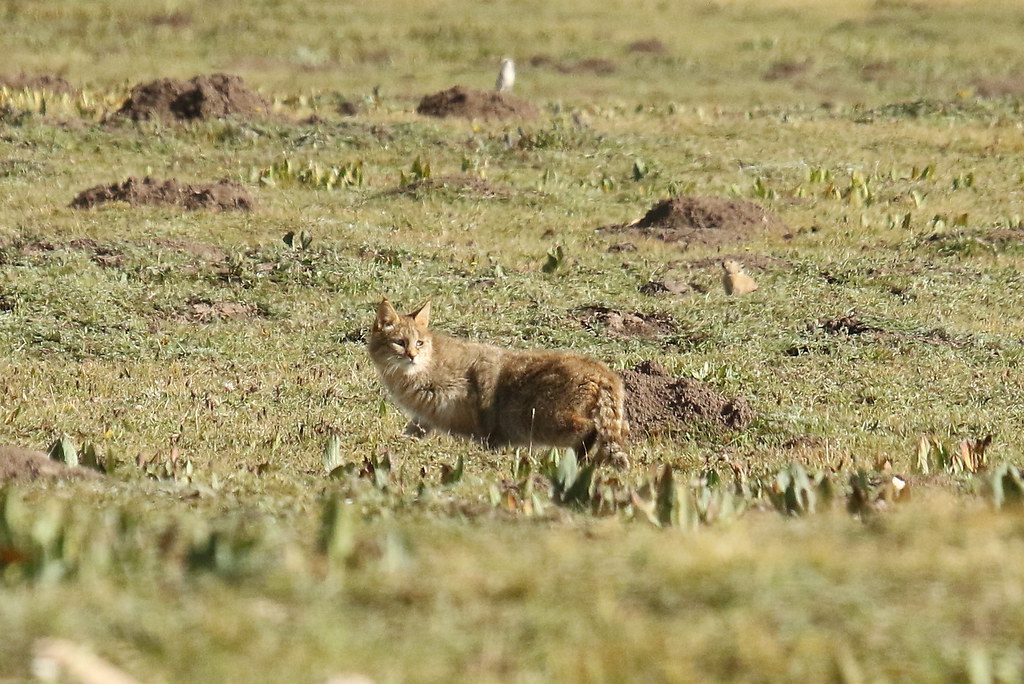 |
| Photograph from Xining Zoo used to illustrate for example the article on the Chinese Mountain Cat on Wikipedia |
According to Birula this cat differs from F. pallida (=bieti) in being redder in colour and more distinctly striped transversely. The back has a longitudinal band tawny fuscous and varied with black; the head is marked with short fuscous lines and three stripes on the cheek; the ears behind are reddish grey and spotted with white at the base and apically pencilled; the lips, chin and throat are white, with a wide, reddish band on the throat; the abdomen is white with black spots; the tail is shortish and coloured like the back, with four or five thin black stripes and a black tip at its distal end. All the apparent differences from bieti might be individual, perhaps seasonal.
This cat had been described by A.A. Bialynicky-Birula (1864-1938) of St Petersburg in 1917 as a new species, Felis chutucha, from the Gobi Desert in Southern Mongolia. It was later lumped first into Felis pallida and then when pallida was recognised as a synonym of F. bieti into bieti, with Pocock having it from 1943 as the second subspecies.
However, Pocock noted there was something odd about the skull or at least about the several authors who had described it and used it for taxonomic purposes. Later authors have considered the skull of chutucha to be that of a Wildcat. Indeed some people have included it in the mammalian fauna of Mongolia and have called it the Gobi Cat, Felis silvestris chutucha. These authors include Haltenorth in 1953 and the late Colin Groves in 1980. I have not seen their papers. This view on the skull has been upheld by the observations of A. Abramov reported in the very recent Revised Taxonomy of the Felidae.
The place where the specimen of chutucha were collected from was not the Gobi Desert. The original location was identified by He et al. (2004) as Ningxia in Inner Mongolia, not that far from its known present distribution. I say ‘specimen’ because the Museum in St Petersburg has the skin (the description of which is in Pocock) and a skull. The skin and skull were collected during Pyotr Kozlov’s expedition in 1908—one of those which during The Great Game gave the British the heebie-jeebies about Russian encroachment into India. I know nothing of the circumstances of the collection of those two specimens but given the vicissitudes of collecting and labelling and knowing that skins were traded commercially, is it possible that the skin and the skull are not from the same animal?
Confusing as all this is and hanging on a single skin and a single skull, we now have some intriguing possibilities. If the skin really is indistinguishable from that of those animals collected and kept alive in Xining and if the skull did not belong to the same animal as the skin, then there is clearly some variation in the coloration of F. bieti which would either restore Pocock’s classification in two subspecies or point to a cline from greyish-sandy with faint stripes to more reddish with stronger stripes in the north. However, and again if the skin really is indistinguishable from that of those animals collected and kept alive in Xining, but the skin and skull in St Petersburg are from the same animal, then because the experts consider the skull be be that of a Wildcat and not F. bieti, then those specimens in Xining are/were not Chinese Mountain Cats at all but either a distinctive and undescribed form of the Asian Wildcat or a closely-related but undescribed species.
 |
| Caroline Simpson's photograph (from Flickr) of a Chinese Mountain Cat on the Tibetan Plateau of Sichuan, September 2017, as a reminder of what Pocock's Felis bieti bieti looks like |
Such are the difficulties of dealing with very few specimens of difficult provenance and illustrate why we need to know much more about the small cats of the world in general and of the still wild parts of China in particular.
Still confused about small cats? Then throw in the domestic cat and the possibility of it appearing in a bewildering variety of colour, patterns and shapes and of it hybridising with local wild cat species, then there is plenty of scope to be even more confused. Working out who’s who in the cats of the world has a long way to run.
References are shown in the previous post.
No comments:
Post a Comment